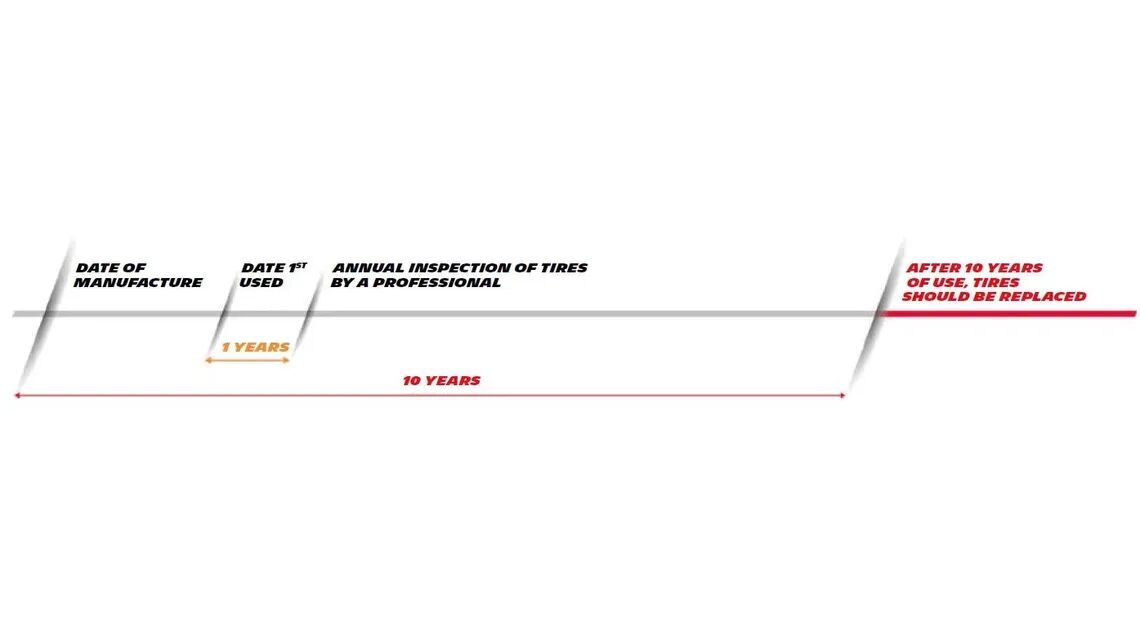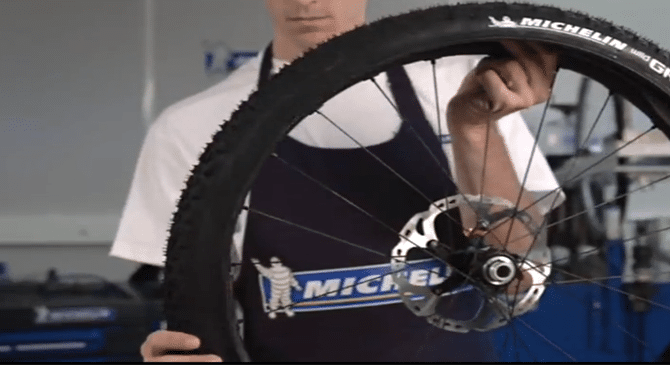When to replace bike tyres?
Wear is, of course, the most important factor in determining how long a bike tyre lasts and therefore the need to replace it, although, as we'll see below, age is also a factor.
When is a tyre considered to be worn?
First of all, it's important to mention that in most cases it's the rear tyre that wears out the fastest. Here are the main signs of wear that appear with repeated use:
- With mountain biking, trekking and gravel tyres, the studs erode over time, resulting in a drop in performance. This is particularly true in terms of grip, traction and braking.
- In road use, including city tyres, the tread eventually flattens and the underlying plies appear.
If you notice this type of condition, it's time to replace your bike tyres.
Causes of bike tyre wear
Tyre wear related to driving style
In mountain biking or gravel, your riding style can influence tyre wear. Particularly if you use micro-locking (if you like to drift the rear wheel to "turn square" instead of "turn round"). This will give you more thrills, but will have a greater impact on rear tyre wear.
For road and city use, it's more a question of how you approach downhill sections that your riding style can affect wear. Particularly if you pick up speed on a slope and brake late. Locking the rear wheel in this way increases wear and can reduce tyre life if you do it frequently.

Tyre wear related to your experience
In mountain biking, experienced riders generally ride faster than beginners, but they don't necessarily wear out their tyres more quickly. Thanks to their experience, they tend to handle their bikes with more confidence and lock their wheels less often. For the same number of riding hours, beginners generally wear out their tyres more quickly because they lock up more often. If you're just starting out, don't worry! With time, you'll learn to tackle courses with more confidence.
Tyre wear related to track knowledge
In mountain biking, familiarity with the route is also a factor. If you're familiar with the route, you'll ride with more confidence and will therefore have fewer wheel lock-ups than on a new, unfamiliar circuit. In the latter case, natural caution is called for, with more braking to avoid being caught out, which has an impact on tyre wear.
Tyre wear related to incorrect tyre pressure
On a road bike, the tyres have no tread. As a result, tyre pressure has little impact on wear. This also applies on City and specific gravel tyres such as the Power Adventure, which do not have a deep tread pattern.
But on off-road rides, over-inflated tyres can have an impact on wear: the contact area is reduced and the effort is therefore applied to fewer studs, which will then wear more quickly. Also, as an over-inflated tyre deforms less, it loses grip potential and wheel lock-ups are quicker and less controllable, leading to slipping and therefore premature tyre wear.
Choose a low-pressure tyre instead. In this case, the contact surface is wider, offering more grip and less slippage under braking, which results in slower wear.
Tyre wear related to the terrain
Wet / dry ground
In mountain biking and gravel, less wear is observed on wet terrain than on dry terrain. Even if there is some slippage, humidity involves less heating up and therefore causes less wear.

Hard / soft ground
The hardness of a terrain affects the wear of the tyres on a mountain bike or gravel bike. Bear in mind that riding on hard ground (e.g. asphalt) with off-road studded tyres will cause faster wear than on soft ground. Make sure you choose tyres that are suited to the type of terrain you will be riding on.
Uphill and downhill
Whether you're going uphill or downhill with a MTB or gravel bike, there is an impact on tyre wear: uphill, because more power is used, which adds to wear. Downhill, because there is more braking and wheel locking. Consequently, intensive use of inclined terrain will accelerate tyre wear. This is also true for road, with riders riding in mountainous locations wearing faster their tyres because of higher torque and different weight repartition when riding uphill.
What about electric bike tyres?
Electric assistance provides more power, but this also has an impact on tyre wear. In fact, with a factor of ten increase in power, it is estimated that wear can occur twice as quickly as on a non-electric bike. And although it affects mainly the rear tyre, it also occurs at the front because of the weight of the bike. An electric bike is heavier because of the battery and motor. And this extra weight implies harder braking, which leads to greater stress on the contact patch and therefore faster wear.

Tyre maintenance tips
Carry out regular inspections
We recommend that you inspect your tyres after every ride to check for any micro-cuts. The tread may have been attacked by sharp elements or stones. If so, check whether the scratches are deep or not and remove any objects that could penetrate the tyre and cause deflation.
If your tyres are Tubeless Ready, check that small cuts have not been plugged up by the sealant without you noticing. These could reopen in the future. If in doubt, consult a professional.
Cleaning products
When cleaning your bike tyres:
- Do not use high-pressure washers directly on the tyre as it can cause damage.
- Do not use solvents and cleaning products to clean the tyres.
- In case bike cleaning products come into contact with your tyres, be sure to rinse thoroughly with clean water.
Tyre storage
All our bicycle tyres must be stored, if possible, in a cool, dry place away from direct light and temperature variations. Michelin advises against storing tyres where temperatures fall below 0°C.
When you store your bicycle, the tyres will naturally lose pressure. If you know you're going to be away for a long time, reverse the bike or remove the wheels and hang them up to prevent them from deforming under the weight of the bike.
Foldable bead tyres should be stored folded in the same way they were folded in their original packaging. Never fold tyres with ridged, wire beads.
How long do bike tyres last?
Even if you don't use them, or not very often, tyres age too, and this is a factor that needs to be taken into account when considering their lifespan.
The aging of a tyre depends solely on the conditions under which it has been stored and
how it has been used. For example, a new tyre that has been parked or stored next to a transformer may show irreversible sidewall damage (cracking) within a few days, which will affect its performance and ability to retain its pressure.

Under normal conditions, a tyre hardens and cracks over time, which can lead to micro-cuts.
To give you a rough idea, consider that a tyre has a lifespan of 10 years from the time it is manufactured. After the first year of use, we recommend that you have your tyres inspected by a professional.


